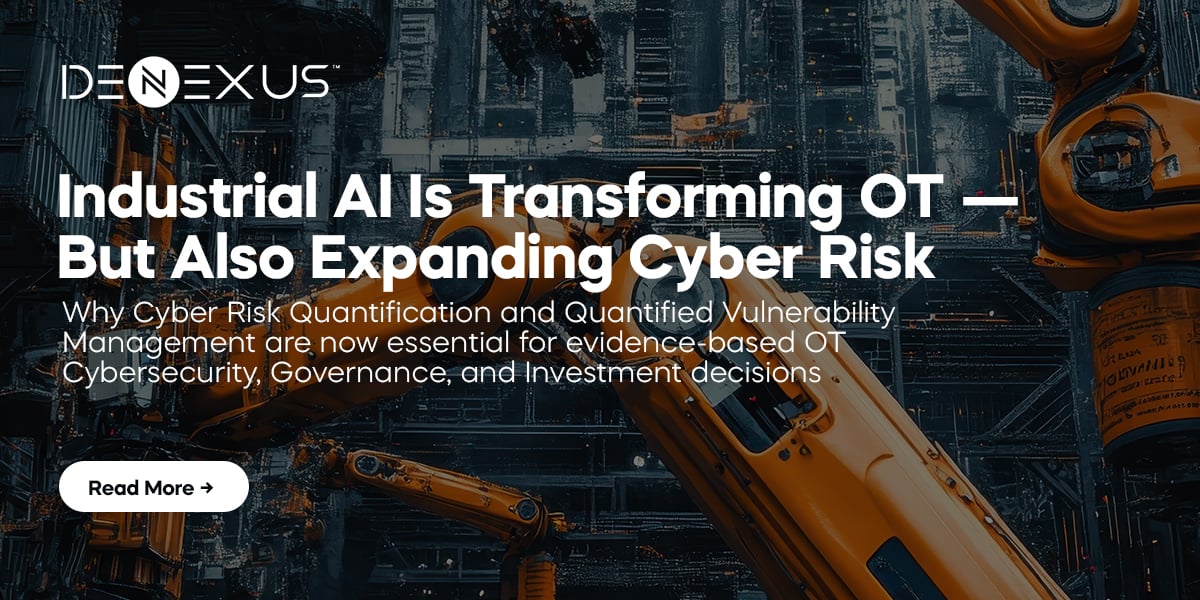Industrial AI is accelerating across manufacturing, energy, transportation, and critical infrastructure. The ISA Industrial AI Position Paper highlights the immense operational benefits of generative models, digital twins, predictive maintenance, and autonomous control systems—while also warning of an unprecedented expansion of cyber-physical risk that traditional qualitative methods can no longer manage effectively.
For OT asset owners, the challenge is clear: AI introduces powerful capabilities, but also new, opaque attack surfaces that must be quantified, governed, and financially modeled to meet board-level expectations. This is where industrial cyber risk quantification becomes essential.
The Expanding Cyber Risk Landscape in Industrial AI
Modern AI systems operate across vast data pipelines, open-source dependencies, and autonomous decision loops. ISA identifies several critical risk categories that directly impact operational technology (OT) security:
AI-Driven Vulnerability Classes
- Data Poisoning & Inference Attacks: Manipulated or leaking datasets threaten predictive models, maintenance analytics, and optimization algorithms.
- Generative AI Threats: Prompt injection, adversarial triggers, goal hijacking, and model drift introduce risks unique to large generative systems.
- Open-Source and Supply-Chain Exposure: A compromised model or Python library can silently propagate into industrial control systems.
- Insider Threats: Workforce displacement associated with AI adoption increases sabotage and data-leakage risk.
- Systemic Concentration Risk: AI’s dependence on a small number of corporate ecosystems introduces geopolitical and single-point-of-failure concerns.
AI is no longer an add-on to automation—it is embedded in control loops, engineering workflows, operational decision-making, and predictive functions. This exponentially raises the stakes for OT Cyber Risk Management.
Why Industrial Leaders Must Quantify AI-Driven Cyber Risk
ISA states unequivocally that qualitative assessments cannot keep pace with the complexity and opacity of AI systems.
Cyber Risk Quantification is now essential for:
Measuring Exposure Across the AI Lifecycle
From data ingestion to model deployment, AI introduces multilayered attack surfaces that must be modelled in financial and operational terms.
Establishing AI-Aligned Security Standards
ISA calls for expanding ISA/IEC 62443 to include AI-specific controls, behavioral assurance, and data-governance requirements.
Continuous Monitoring Through Digital Twins
AI-enabled automation requires real-time modelling of cyber-physical interactions—not periodic checklists.
Governance, Ethics, and Compliance
Boards and regulators increasingly expect evidence-based cybersecurity decisions supported by Quantified Risk Metrics and clear audit trails.
Without Industrial Cyber Risk Quantification, organizations cannot credibly justify budgets, prioritize controls, validate OT security architectures, or optimize cyber insurance strategies.
How DeNexus Addresses ISA’s Requirements for AI-Age OT Security
DeNexus’ DeRISK platform delivers a full-stack solution to Industrial Cyber Risk Management by transforming complex AI and OT exposures into measurable financial intelligence. It directly aligns with ISA’s recommendations in four key areas.
- Quantifying New AI-Driven Cyber Risks
DeRISK models threats and vulnerabilities. It will keep growing and adding the new threats introduced by generative AI, providing:
- Annual expected loss and value-at-risk (VaR) for cyber incidents
- Financial impact projections for OT asset owners
This clarity allows CISOs and CFOs to communicate risk in quantitative terms the board immediately understands.
- Enabling Continuous, Evidence-Based Cyber Governance
Using digital twins and data-driven analytics to simulate attacks, DeRISK provides:
- continuous risk quantification
- scenario simulations
- quantified vulnerability management (QVM) for OT
- risk-based prioritization of vulnerabilities
This shifts organizations from reactive compliance to proactive and evidence-based cybersecurity.
- Driving Better Business, Insurance, and Investment Decisions
By quantifying cyber risk in financial language, DeRISK empowers executives to:
- prioritize risk-based cybersecurity investments
- optimize cyber insurance coverage and premiums
- validate capital expenditures
- justify cybersecurity investments in ICS/OT systems
With quantification, cybersecurity becomes a business decision—not a cost centre.
Conclusion: Industrial AI Demands a Quantitative Cyber Risk Strategy
ISA’s position is clear: AI brings transformative potential—and equally transformative cyber-physical risk.
The future of OT cybersecurity requires:
- quantitative models,
- continuous monitoring,
- AI-aligned standards, and
- risk-based cybersecurity investments and programs.
DeNexus provides the quantitative backbone needed to convert uncertainty into measurable, actionable, and financially interpretable insights.
Start quantifying your cyber-physical risk today.
- Explore Cyber Risk Quantification (CRQ):


